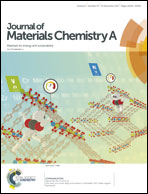Polaron size and shape effects on oxygen vacancy interactions in lanthanum strontium ferrite†
Abstract
Both aliovalent doping and the charge state of multivalent lattice ions determine the oxygen non-stoichiometry (δ) of mixed ionic and electronic conductors (MIECs). Unfortunately, it has been challenging for both modeling and experiments to determine the multivalent ion charge states in MIECs. Here, the Fe charge state distribution was determined for various compositions and phases of the MIEC La1−xSrxFeO3−δ (LSF) using the spin-polarized density functional theory (DFT)-predicted magnetic moments on Fe. It was found that electron occupancy and crystal-field-splitting-induced differences between the Fe 3d-orbitals of the square pyramidally coordinated, oxygen-vacancy-adjacent Fe atoms and the octahedrally-coordinated, oxygen-vacancy-distant-Fe atoms determined whether the excess electrons produced during oxygen vacancy formation remained localized at the first nearest neighbor Fe atoms (resulting in small oxygen vacancy polarons, as in LaFeO3) or were distributed to the second-nearest-neighbor Fe atoms (resulting in large oxygen vacancy polarons, as in SrFeO3). The progressively larger polaron size and anisotropic shape changes with increasing Sr resulted in increasing oxygen vacancy interactions, as indicated by an increase in the oxygen vacancy formation energy above a critical δ threshold. This was consistent with experimental results showing that Sr-rich LSF and highly oxygen deficient compositions are prone to oxygen-vacancy-ordering-induced phase transformations, while Sr-poor and oxygen-rich LSF compositions are not. Since oxygen vacancy induced phase transformations cause a decrease in the mobile oxygen vacancy site fraction (X), both δ and X were predicted as a function of temperature and oxygen partial pressure, for multiple LSF compositions and phases using a combined thermodynamics and DFT approach.



 Please wait while we load your content...
Please wait while we load your content...